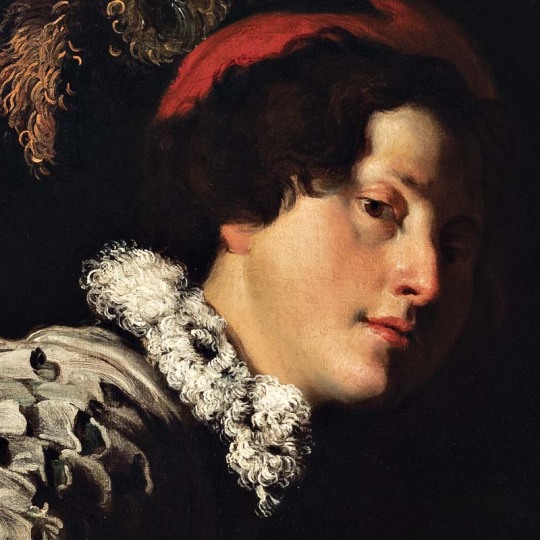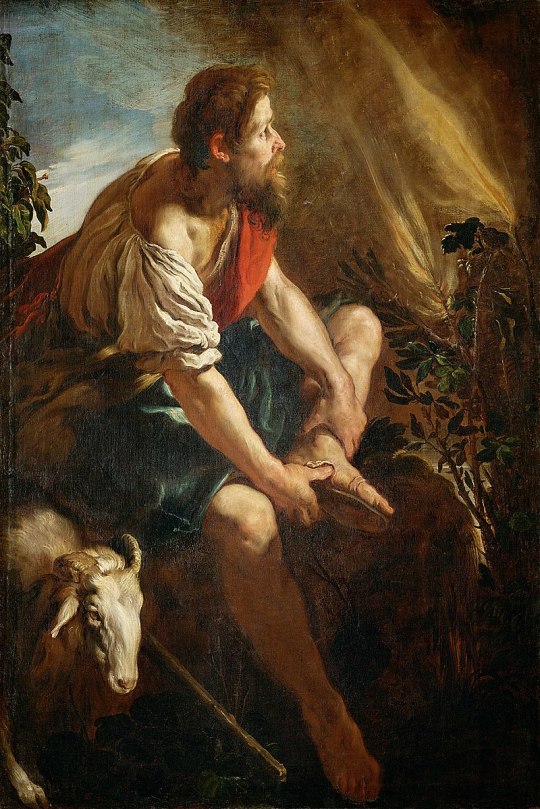#Domenico Fetti
Explore tagged Tumblr posts
Text

Attributed to Domenico Fetti (c. 1589-1623) "David with the Head of Goliath" (c. 1610-1620) Oil on canvas Baroque
#paintings#art#artwork#religious painting#david and goliath#domenico fetti#oil on canvas#baroque#italian artist#male portrait#portrait of man#costume#costumes#sword#swords#king david#christianity#1610s#1620s#early 1600s#early 17th century
320 notes
·
View notes
Text

Domenico Fetti - Melancholia (c.1615)
148 notes
·
View notes
Text

Perseus freeing Andromeda (Domenico Fetti, c. 1622)
31 notes
·
View notes
Photo

St. Johannes der Evangelist von Domenico Fetti (Feti) (Öl auf Leinwand)
#kunst#kunstwerk#art#artwork#domenico fetti#künstler#artist#religion#religiöse kunst#religious art#mann#man#johannes#john#st. johannes#heiliger johannes#saint john#apostel#apostle#jünger#disciple#evangelist#bibel#bible#gott#god#vater#father#herr#lord
27 notes
·
View notes
Text

Domenico Fetti
15 notes
·
View notes
Text

Santa María Magdalena, por Domenico Fetti
#domenico fetti#maria magdalena#mary magdalene#christian art#christianity#skull#arte#art#religion#religious art
15 notes
·
View notes
Text



Domenico Fetti (1589-1623)
David with the Head of Goliath, circa 1617-20
#Domenico Fetti#painter#painting#art#artwork#history of art#17th century#baroque#renaissance#holy scripture#biblical
31 notes
·
View notes
Text
Illuminating Liberation
Domenico Fetti's Moses and the Burning Bush and Essential Reads on Resistance in Abrahamic Faiths

Domenico Fetti’s Moses and the Burning Bush (1613) captures one of the most significant moments in biblical history—the divine call of Moses to lead the Israelites out of bondage in Egypt. Created during Fetti’s tenure in Mantua, the work exemplifies the Baroque fascination with dramatic storytelling, emotional intensity, and the use of light to symbolize divine presence. In this painting, Moses kneels before the miraculous burning bush, which is enveloped in glowing, otherworldly flames that do not consume it—a powerful visual representation of God’s eternal and unchanging nature.
Fetti rose to prominence during his time at the court of Mantua, a historic city in the Lombardy region of Italy, which is now a UNESCO World Heritage Site for its significant role in the Italian Renaissance and Baroque periods, particularly as the seat of the Gonzaga family. The Gonzaga court’s support allowed Fetti to experiment with devotional imagery, exploring sacred themes with human emotion until his untimely death at the age of 34, likely from tuberculosis.
Fetti’s depiction is characteristic of Baroque art, with its rich, dynamic use of chiaroscuro (the interplay of light and shadow) to highlight Moses’s awestruck expression and the supernatural glow of the bush. The painting also reflects the Catholic Counter-Reformation emphasis on personal, emotional engagement with biblical narratives, encouraging viewers to reflect on themes of divine justice and human obedience. Historically, the story of Moses and the burning bush became a symbol of resistance and liberation, particularly resonating with oppressed communities who saw in Moses a model for standing against authoritarian power and leading movements for freedom and justice.
Abrahamic Religious Scholarship on anti-authoritarianism
There is a rich field of non-fiction literature and theological analysis exploring themes of resistance to authoritarianism within the Abrahamic faiths (Judaism, Christianity, and Islam). These works often focus on scriptural interpretations, historical events, and ethical frameworks that speak to the ways in which each faith tradition has engaged with political authority, justice, and social resistance.
Here's a reading list of some works that examine these themes:
1. "God and Empire: Jesus Against Rome, Then and Now" by John Dominic Crossan
Crossan, a prominent scholar of early Christianity, explores how Jesus’ teachings and actions represented a subversive response to Roman imperialism and authoritarian power structures. Crossan argues that Jesus’s message was one of nonviolent resistance against the oppressive rule of Rome and that this anti-imperial stance has important implications for contemporary Christian social ethics.
2. "The Prophets" by Abraham Joshua Heschel
Heschel’s classic work focuses on the prophetic tradition in Judaism, highlighting how prophets such as Isaiah, Jeremiah, and Amos spoke out against injustice, idolatry, and the abuse of power. Heschel argues that the Hebrew prophets were deeply committed to resisting social and political corruption, presenting them as models for ethical resistance to authoritarianism in all ages.
3. "Jesus and the Disinherited" by Howard Thurman
Thurman’s work connects the life and teachings of Jesus to the experience of marginalized and oppressed communities. Written during the Jim Crow era, this influential book argues that Jesus’ teachings provide a blueprint for resisting social injustice and authoritarian oppression, emphasizing love, nonviolence, and solidarity with the poor and disinherited.
4. "Islam and the Challenge of Democracy" by Khaled Abou El Fadl
Abou El Fadl is a prominent scholar of Islamic law who argues that Islamic ethics support democratic values and resistance to authoritarian rule. In this book, he addresses how Islamic teachings on justice, human dignity, and accountability can be mobilized to critique and resist political authoritarianism within Muslim-majority societies.
5. "The Politics of Jesus" by John Howard Yoder
Yoder, a pacifist theologian, argues that Jesus’ life and teachings exemplify a radical, nonviolent form of resistance to political power and violence. Yoder’s work has influenced many Christian movements advocating for social justice and nonviolent resistance, framing Jesus’ message as fundamentally opposed to authoritarianism and state violence.
6. "The Cross and the Lynching Tree" by James H. Cone
Cone, a foundational figure in Black Liberation Theology, explores the connections between the suffering of Jesus on the cross and the historical suffering of Black Americans under slavery and segregation. He argues that the Christian cross should be understood as a symbol of solidarity with the oppressed and a call to resist systems of authoritarianism and racism.
7. "Religion and Resistance in America" by various authors, edited by Allan D. Cooper
This anthology examines the role of religion as a force for social resistance in American history, focusing on various religious movements that have resisted authoritarian and oppressive systems. The essays cover a range of Abrahamic perspectives, including Jewish, Christian, and Muslim perspectives on resistance to authoritarianism in the U.S. context.
8. "The Powers That Be: Theology for a New Millennium" by Walter Wink
Wink’s work examines the "principalities and powers" mentioned in the New Testament as forces that seek to dominate humanity. He interprets these as both spiritual and institutional powers that people are called to resist. Wink explores how individuals and communities can resist these powers nonviolently, drawing from both biblical theology and contemporary social movements.
9. "The Islamic Roots of Democratic Pluralism" by Abdulaziz Sachedina
Sachedina examines democratic principles within the Qur'an and Islamic ethics, challenging authoritarian interpretations of Islamic governance. He highlights the role of justice, consultation (shura), and human rights within Islam, advocating for political systems that respect pluralism, accountability, and the inherent dignity of all people.
10. "Render Unto Caesar: The Struggle Over Christ and Culture in the New Testament" by Christopher Bryan
Bryan examines the New Testament’s treatment of political authority, focusing on passages like “Render unto Caesar” and exploring how early Christians navigated their obligations to the Roman Empire. He argues that while the New Testament acknowledges earthly authority, it also critiques the abuse of power and emphasizes the sovereignty of God over human rulers.
11. "God’s Revolution: Justice, Community, and the Coming Kingdom" by Eberhard Arnold
Arnold, founder of the Bruderhof community, draws on Anabaptist and early Christian traditions to argue for a nonviolent resistance to authoritarianism. His work emphasizes the need for Christians to embody an alternative, justice-oriented community that challenges worldly power structures.
12. "Sacred Resistance: A Practical Guide to Christian Witness and Dissent" by Ginger Gaines-Cirelli
This book offers practical advice for Christians seeking to engage in social resistance while staying rooted in their faith. Gaines-Cirelli discusses how biblical teachings can inspire action against authoritarianism, injustice, and other social ills, with a focus on nonviolent witness and advocacy.
13. "The Jewish Political Tradition, Vol. 1: Authority" by Michael Walzer, Menachem Lorberbaum, and Noam J. Zohar
This volume explores Jewish thought on political authority, autonomy, and resistance to tyranny throughout history. Drawing on classical and modern Jewish sources, the authors discuss how Jewish communities have interpreted and responded to political power, including themes of resistance and critique of authoritarianism.
14. "Islamic Liberation Theology: Resisting the Empire" by Hamid Dabashi
Dabashi explores the roots of Islamic liberation theology, analyzing how Islamic teachings support resistance to imperialism and authoritarianism. He argues that Islam offers a framework for anti-colonial and anti-authoritarian resistance, connecting the Qur'an’s themes of justice, liberation, and the prophetic tradition with contemporary movements for freedom.
15. "Faith-Rooted Organizing: Mobilizing the Church in Service to the World" by Alexia Salvatierra and Peter Heltzel
This book provides a framework for faith-based social activism, drawing from both Christian and Jewish teachings on justice and resistance. The authors offer guidance on organizing efforts against oppressive structures, emphasizing the role of faith communities in advocating for systemic change.
16. "Exodus and Revolution" by Michael Walzer
Walzer’s analysis of the Exodus story in the Hebrew Bible interprets it as a foundational narrative of liberation, justice, and resistance to oppression. He argues that the Exodus has been used throughout history as a powerful model for resisting authoritarianism and envisioning a just society.
#art#art history#baroque#abrahamic religions#christianity#christian blog#books and reading#literature reviews#reading list#theology#anti authoritarian#authoritarianism#resistence#domenico fetti#moses#bibliophile#ancient history#catholicism
5 notes
·
View notes
Text

Ancient poet by Domenico Fetti (1589-1623)
39 notes
·
View notes
Text

Vanitas - Domenico Fetti
3 notes
·
View notes
Text

Domenico Fetti Hero Mourning the Dead Leander 1621-22
15 notes
·
View notes
Text

David with the Head of Goliath (Domenico Fetti, 1610-20)
25 notes
·
View notes
Text

Domenico Fetti, Sleeping Girl, 1620 - 1622.
30 notes
·
View notes
Text

Jacob's Dream of the Ladder to Heaven
Artist: Domenico Fetti (Italian, 1589-1623)
Date: Circa 1619
Medium: Oil on Poplar Wood
Collection: Kunsthistorisches Museum, Vienna, Austria
Jacob’s Dream at Bethel | Genesis 28:10-17
Jacob left Beersheba and set out for Harran. When he reached a certain place, he stopped for the night because the sun had set. Taking one of the stones there, he put it under his head and lay down to sleep. He had a dream in which he saw a stairway resting on the earth, with its top reaching to heaven, and the angels of God were ascending and descending on it. There above it stood the Lord, and he said: “I am the Lord, the God of your father Abraham and the God of Isaac. I will give you and your descendants the land on which you are lying. Your descendants will be like the dust of the earth, and you will spread out to the west and to the east, to the north and to the south. All peoples on earth will be blessed through you and your offspring. I am with you and will watch over you wherever you go, and I will bring you back to this land. I will not leave you until I have done what I have promised you.”
When Jacob awoke from his sleep, he thought, “Surely the Lord is in this place, and I was not aware of it.” He was afraid and said, “How awesome is this place! This is none other than the house of God; this is the gate of heaven.”
#religious art#oil#poplar wood#painting#domenico fetti#italian painter#european art#17th century painting#bible story#old testament#book of genesis#jacob#dream#angels#landscape#bible quote#stairway#promise of god#christianity
13 notes
·
View notes
Text

Domenico Fetti
6 notes
·
View notes
Text

Sleeping Girl - Domenico Fetti // The Sweetness - Ashton Irwin
#the sweetness#the sweetness lyrics#the sweetness ashton irwin#the sweetness ai#ashton irwin#ai#fine art#domenico fetti#Ashton Irwin edit#my edit#ai edit#superbloom
4 notes
·
View notes